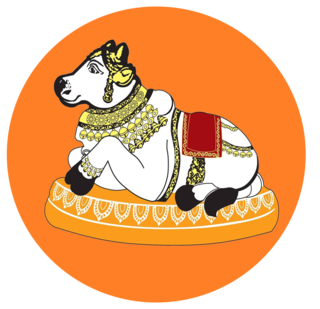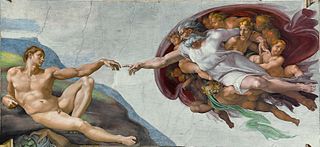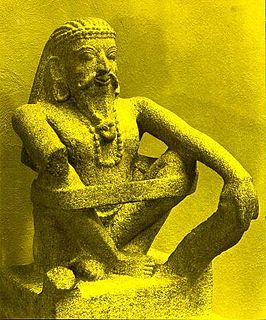
Nirvāṇa is commonly associated with Hinduism, Jainism and Buddhism, and represents its ultimate state of soteriological release, the liberation from repeated rebirth in saṃsāra.
The Upanishads, a part of the Vedas, are ancient Sanskrit texts that contain some of the central philosophical concepts and ideas of Hinduism, some of which are shared with religious traditions like Buddhism and Jainism. Among the most important literature in the history of Indian religions and culture, the Upanishads played an important role in the development of spiritual ideas in ancient India, marking a transition from Vedic ritualism to new ideas and institutions. Of all Vedic literature, the Upanishads alone are widely known, and their central ideas are at the spiritual core of Hindus.

Advaita Vedanta, originally known as Puruṣavādha, is a school of Hindu philosophy, and believed to be one of the classic paths to spiritual realization in Hindu tradition. The term Advaita refers to its idea that the true self, Atman, is the same as the highest metaphysical Reality (Brahman). The followers of this school are known as Advaita Vedantins, or just Advaitins or Mayavaadis, and they seek spiritual liberation through acquiring vidyā, meaning knowledge, of one's true identity as Atman, and the identity of Atman and Brahman.

Hindu philosophy refers to a group of darśanas that emerged in ancient India. These include six systems (ṣaḍdarśana) – Sankhya, Yoga, Nyaya, Vaisheshika, Mimamsa and Vedanta. These are also called the Astika (orthodox) philosophical traditions and are those that accept the Vedas as an authoritative, important source of knowledge. Ancient and medieval India was also the source of philosophies that share philosophical concepts but rejected the Vedas, and these have been called nāstika Indian philosophies. Nāstika Indian philosophies include Buddhism, Jainism, Cārvāka, Ājīvika, and others.
In Hinduism and Jainism, the jiva is a living being, or any entity imbued with a life force. The word itself originates from the Sanskrit jivás, with the root jīv- "to live". It has the same Indo-European root as the Latin word vivus, meaning "alive".
Bhakti yoga, also called Bhakti marga, is a spiritual path or spiritual practice within Hinduism focused on loving devotion towards a personal god. It is one of the paths in the spiritual practices of Hindus, others being Jnana yoga and Karma yoga. The tradition has ancient roots. Bhakti is mentioned in the Shvetashvatara Upanishad where it simply means participation, devotion and love for any endeavor. Bhakti yoga as one of three spiritual paths for salvation is discussed in depth by the Bhagavad Gita.
Paramatman or Paramātmā is the Absolute Atman, or supreme Self, in various philosophies such as the Vedanta and Yoga schools in Hindu theology, as well as other Indian religions like Sikhism. The Paramatman is the "Primordial Self" or the "Self Beyond" who is spiritually practically identical with the Absolute, identical with the Brahman. Selflessness is the attribute of Paramatman, where all personality/individuality vanishes.
Satchitananda or Sacchidānanda representing "existence, consciousness, and bliss" or "truth, consciousness, bliss", is an epithet and description for the subjective experience of the ultimate, unchanging reality in Hinduism called Brahman.

Paraméshwara or Paramashiva is the term usually referred to the Hindu god Shiva as the Supreme being according to Saivism which is one of 4 major sampradaya of Hinduism. Parameshwara is the ultimate reality and nothing exists that is non one with Paramashiva. He is the totality controlling the triple forces of creation, preservation and destruction.

The Katha Upanishad is one of the mukhya (primary) Upanishads, embedded in the last short eight sections of the Kaṭha school of the Krishna Yajurveda. It is also known as Kāṭhaka Upanishad, and is listed as number 3 in the Muktika canon of 108 Upanishads.

Hinduism includes a range of viewpoints about the origin of life, creationism and evolution. There is no single story of creation, due to dynamic diversity of Hinduism, and these are derived from various sources like Vedas, some from the Brahmanas, some from Puranas; some are philosophical, based on concepts, and others are narratives. The Rigveda mentions the Hiranyagarbha as the source of the creation of the Universe, similar to the world egg motif found in the creation myths of many other civilizations. It also contains a myth of proto-Indo-European origin, in which the creation arises out of the dismemberment of a cosmic being who is sacrificed by the gods. As for the creation of the primordial gods themselves, the Nasadiya Sukta of Rigveda takes a near-agnostic stand, stating that the Gods came into being after the world's creation, and nobody knows when the world first came into being. In the later Puranic texts, the creator god Brahma is described as performing the act of 'creation', or more specifically of 'propagating life within the universe'. Some texts consider him equivalent to the Hiranyagarbha or the Purusha, while others state that he arose out of these. Brahma is a part of the trinity of gods that also includes Vishnu and Shiva, who are responsible for 'preservation' and 'destruction' respectively.
Pasha, often translated as "noose" or "lasso", is a supernatural weapon depicted in Hindu iconography. Hindu deities such as Ganesha, Yama and Varuna are depicted with the pasha in their hands.

In Hinduism, Brahman connotes the highest Universal Principle, the Ultimate Reality in the universe. In major schools of Hindu philosophy, it is the material, efficient, formal and final cause of all that exists. It is the pervasive, genderless, infinite, eternal truth and bliss which does not change, yet is the cause of all changes. Brahman as a metaphysical concept is the single binding unity behind diversity in all that exists in the universe.
Pasha or Paşa, in older works sometimes anglicized as bashaw, was a higher rank in the Ottoman political and military system, typically granted to governors, generals, dignitaries and others. As an honorary title, Pasha, in one of its various ranks, is similar to a British peerage or knighthood, and was also one of the highest titles in the 20th century Kingdom of Egypt.

The Kara Ahmed Pasha Mosque or Gazi Ahmed Pasha Mosque is a 16th century Ottoman mosque near the city walls in Istanbul, Turkey. It was designed by the imperial architect Mimar Sinan and completed in around 1572.
The Jīva or Atman is a philosophical term used within Jainism to identify the soul. As per the Jain cosmology, jīva or soul is the principle of sentience and is one of the tattvas or one of the fundamental substances forming part of the universe. The Jain metaphysics, states Jagmanderlal Jaini, divides the universe into two independent, everlasting, co-existing and uncreated categories called the jiva (soul) and the ajiva (non-soul). This basic premise of Jainism makes it a dualistic philosophy. The jiva, according to Jainism, is an essential part of how the process of karma, rebirth and the process of liberation from rebirth works.

Mesih Mehmed Pasha Mosque is a 16th-century Ottoman mosque in the Fatih district of Istanbul. It was commissioned by one of Murad III's grand viziers, Mesih Mehmed Pasha, and designed by the imperial architect Mimar Sinan. The mosque was completed in 1585–86.

The Jabali Upanishad, also called Jabalyupanishad, is a Sanskrit text and one of the minor Upanishads of Hinduism. It is attached to the Samaveda, and classified as is one of the Shaiva Upanishads.

The Mantrika Upanishad is a minor Upanishad of Hinduism. The Sanskrit text is one of the 22 Samanya Upanishads, is part of the Vedanta and Yoga schools of Hindu philosophy literature, and is one of 19 Upanishads attached to the Shukla Yajurveda. In the Muktika canon, narrated by Rama to Hanuman, it is listed at number 32 in the anthology of 108 Upanishads.











